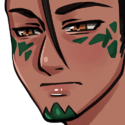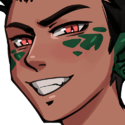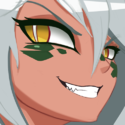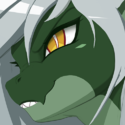Difference between revisions of "Wyverns"
m (→Characters) |
|||
| (17 intermediate revisions by the same user not shown) | |||
| Line 1: | Line 1: | ||
| − | + | <blockquote> | |
| − | + | ''"Wyverns are predators. Dangerous on the hunt, moreso if you catch them off guard. Best thing you can do if one sets her eyes on you is just relax and let her do what she wants. If you don't, her venom will make sure you're her plaything whether you like it or not."''<br>—[[Leorah]] | |
| − | + | </blockquote> | |
| − | | | + | __TOC__ |
| − | | | + | ==Writer Credit== |
| − | | | + | {|class="wikitable bordered" border="1" cellpadding="2" style="margin-left: auto; margin-right: auto;text-align:left" |
| − | } | + | |- |
| + | !|[[Author-Savin|Savin]] | ||
| + | |- | ||
| + | | | ||
| + | *Wyverns Codex Entry | ||
| + | |} | ||
| + | ==Codex== | ||
| + | <blockquote> | ||
| + | '''Name:''' Wyvern (pl. Wyverns) | ||
| − | + | '''Sexes:''' Male, Female (roughly equal proportions) | |
| − | |||
| − | + | '''Height:''' Ranges from 6'0 to 7'2 on average. | |
| − | === | + | '''Weight:''' Wyverns weigh considerably more than their human counterparts. |
| + | |||
| + | '''Skin:''' Heavy scale plates cover much of the wyvern's body, though some specimens also have significant amounts of smooth skin. | ||
| + | |||
| + | '''Hair:''' Wyverns grow hair only on their heads, ranging in color from black to blue and gray. | ||
| + | |||
| + | '''Eyes:''' Slitted, golden eyes are the norm. | ||
| + | |||
| + | '''Ears:''' Wyverns possess large, frilled ears similar to those of salamanders. | ||
| + | |||
| + | '''Lifespan:''' Though wyverns can easily live for up to 200 years, most specimens encountered in the wild are between twenty and fifty years of age. | ||
| + | |||
| + | '''Maturity:''' 20 years | ||
| + | </blockquote> | ||
| + | ===Description=== | ||
| + | ---- | ||
| + | <blockquote> | ||
| + | Wyverns are a race of heavily-scaled, winged humanoids native to the various mountain ranges of the world. Though most common in the warmer southlands, their race can be found in just about any part of the world that provides suitable living space for them: somewhere high up, secluded, and rich in game. It is commonly believed that wyverns are descendants of dragons that coupled with mortals, though the scholars of ancient Belhar generally concluded that wyverns had more in common with salamanders than with proper dragons. | ||
| + | |||
| + | Regardless of their origin, it is well known that there are two "sub-races" of wyverns. While all wyvern-folk have heavy, thick scales over much of their bodies, and leathery wings under their arms which allow for limited flight, the degree of bestial features vary between wyverns. Some are covered head-to-toe in scales and sport draconic muzzles, while others are much closer in appearance to humans. What caused this racial split is unknown, but is assumed to be related to the amount of human blood versus that of dragons in the individual wyvern. | ||
| + | |||
| + | Rather than draconic breath, wyverns possess a powerful venom that they use to capture prey. While in most creatures, this venom is a potent paralytic, is is known to, in some victims, produce an aphrodisiac-like effect. Because of this, distilled wyvern venom is a valuable commodity among alchemists in the southlands. | ||
| + | |||
| + | Older wyverns are rarely encountered in the wild, as with age, their species grows considerably more lethargic and easy-going. Elder wyverns have behavior reminiscent of their draconic ancestors, preferring to roost on their accumulated coin and treasure, only venturing out to find food and mates once every few months. | ||
| + | |||
| + | Wyverns are an intelligent race, able (though rarely inclined to) wear clothing and use weapons. However, few if any members of the race have ever been known to speak — either in Belharan or Wyrmtongue. The reason for the race's silence are unknown. Some scholars of ancient Estelore conjectured that a great curse had been levied against their race, while others insist that the wyvern's unique amalgam of draconic and humanoid traits simply render them mute. | ||
| + | </blockquote> | ||
| + | ===Reproduction=== | ||
| + | ---- | ||
| + | <blockquote> | ||
| + | Wyverns are an egg-bearing race, with typical sexual reproduction. Due to their solitary nature and territoriality, wyverns rarely breed with each other; rather, they typically "hunt" for mates among the local population under their mountainous homes. Their venomous bites are particularly useful in this endeavor, preventing their prey from escaping once mounted and ensuring that males remain rigid for repeated couplings. | ||
| + | |||
| + | Wyvern females carry eggs for roughly one month before depositing them in the nest. Once laid, an egg must be meticulously tended to for the next six months before hatching into a small, hairless, and flightless child. Wyvern females produce breast milk starting shortly after their egg-laying, and feed their children thusly for between six months and a year, when the hatchling is able to begin eating solid food. | ||
| + | |||
| + | Young wyverns remain with their mothers for roughly twenty years before being strong and skilled enough to become independent. Unlike harpies — the wyvern's common neighbor — wyvern have no "flock mentality" and will usually leave to find their own hunting grounds shortly after reaching majority. | ||
| + | </blockquote> | ||
| + | ===History=== | ||
| + | ---- | ||
| + | <blockquote> | ||
| + | Wyverns have existed as long as anybody can remember, and probably long before that. The origins of their race are unknown, and before the Godswar put an end to much of civilization, was a topic of much debate among Belharan scholars. | ||
| + | </blockquote> | ||
| + | ===Society & Culture=== | ||
| + | ---- | ||
| + | <blockquote> | ||
| + | Wyverns have no society or culture to speak of, as they are largely independent hunters and, as far as anybody knows, make no art or crafts of their own. On rare occasion, wyverns have been known to salvage weapons and armor from human settlements, or to inhabit ruins, but most simply rely on their natural physique and make their homes in caves and other natural formations. | ||
| + | </blockquote> | ||
| + | |||
| + | ==Codex Acquisition== | ||
| + | Only one of the conditions below must be met to unlock the Wyverns Codex entry: | ||
| + | *Encountering the [[Wyvern Girl]] | ||
| + | |||
| + | ==Other Information== | ||
| + | ===Transformatives=== | ||
---- | ---- | ||
| − | + | No such transformative items exist yet | |
| + | ==Characters== | ||
| + | <tabber> | ||
| + | Generic characters= | ||
| + | {|class="table" style="margin-left: auto; margin-right: auto; border: 2px solid #929292; cellpadding:1px; " | ||
| + | |- | ||
| + | |{{WikiHeadshot-index|name=Frost Wyvern}}{{WikiHeadshot-index|name=Male Wyvern}}{{WikiHeadshot-index|name=Wyvern Girl}}{{WikiHeadshot-index|name=Wyvern Girl|exte=1}} | ||
| + | |}</tabber> | ||
| − | |||
[[Category:Races]] | [[Category:Races]] | ||
| + | [[Category:Wiki page status - Outdated]] | ||
Latest revision as of 14:41, 11 April 2025
"Wyverns are predators. Dangerous on the hunt, moreso if you catch them off guard. Best thing you can do if one sets her eyes on you is just relax and let her do what she wants. If you don't, her venom will make sure you're her plaything whether you like it or not."
—Leorah
Writer Credit
| Savin |
|---|
|
Codex
Name: Wyvern (pl. Wyverns)
Sexes: Male, Female (roughly equal proportions)
Height: Ranges from 6'0 to 7'2 on average.
Weight: Wyverns weigh considerably more than their human counterparts.
Skin: Heavy scale plates cover much of the wyvern's body, though some specimens also have significant amounts of smooth skin.
Hair: Wyverns grow hair only on their heads, ranging in color from black to blue and gray.
Eyes: Slitted, golden eyes are the norm.
Ears: Wyverns possess large, frilled ears similar to those of salamanders.
Lifespan: Though wyverns can easily live for up to 200 years, most specimens encountered in the wild are between twenty and fifty years of age.
Maturity: 20 years
Description
Wyverns are a race of heavily-scaled, winged humanoids native to the various mountain ranges of the world. Though most common in the warmer southlands, their race can be found in just about any part of the world that provides suitable living space for them: somewhere high up, secluded, and rich in game. It is commonly believed that wyverns are descendants of dragons that coupled with mortals, though the scholars of ancient Belhar generally concluded that wyverns had more in common with salamanders than with proper dragons.
Regardless of their origin, it is well known that there are two "sub-races" of wyverns. While all wyvern-folk have heavy, thick scales over much of their bodies, and leathery wings under their arms which allow for limited flight, the degree of bestial features vary between wyverns. Some are covered head-to-toe in scales and sport draconic muzzles, while others are much closer in appearance to humans. What caused this racial split is unknown, but is assumed to be related to the amount of human blood versus that of dragons in the individual wyvern.
Rather than draconic breath, wyverns possess a powerful venom that they use to capture prey. While in most creatures, this venom is a potent paralytic, is is known to, in some victims, produce an aphrodisiac-like effect. Because of this, distilled wyvern venom is a valuable commodity among alchemists in the southlands.
Older wyverns are rarely encountered in the wild, as with age, their species grows considerably more lethargic and easy-going. Elder wyverns have behavior reminiscent of their draconic ancestors, preferring to roost on their accumulated coin and treasure, only venturing out to find food and mates once every few months.
Wyverns are an intelligent race, able (though rarely inclined to) wear clothing and use weapons. However, few if any members of the race have ever been known to speak — either in Belharan or Wyrmtongue. The reason for the race's silence are unknown. Some scholars of ancient Estelore conjectured that a great curse had been levied against their race, while others insist that the wyvern's unique amalgam of draconic and humanoid traits simply render them mute.
Reproduction
Wyverns are an egg-bearing race, with typical sexual reproduction. Due to their solitary nature and territoriality, wyverns rarely breed with each other; rather, they typically "hunt" for mates among the local population under their mountainous homes. Their venomous bites are particularly useful in this endeavor, preventing their prey from escaping once mounted and ensuring that males remain rigid for repeated couplings.
Wyvern females carry eggs for roughly one month before depositing them in the nest. Once laid, an egg must be meticulously tended to for the next six months before hatching into a small, hairless, and flightless child. Wyvern females produce breast milk starting shortly after their egg-laying, and feed their children thusly for between six months and a year, when the hatchling is able to begin eating solid food.
Young wyverns remain with their mothers for roughly twenty years before being strong and skilled enough to become independent. Unlike harpies — the wyvern's common neighbor — wyvern have no "flock mentality" and will usually leave to find their own hunting grounds shortly after reaching majority.
History
Wyverns have existed as long as anybody can remember, and probably long before that. The origins of their race are unknown, and before the Godswar put an end to much of civilization, was a topic of much debate among Belharan scholars.
Society & Culture
Wyverns have no society or culture to speak of, as they are largely independent hunters and, as far as anybody knows, make no art or crafts of their own. On rare occasion, wyverns have been known to salvage weapons and armor from human settlements, or to inhabit ruins, but most simply rely on their natural physique and make their homes in caves and other natural formations.
Codex Acquisition
Only one of the conditions below must be met to unlock the Wyverns Codex entry:
- Encountering the Wyvern Girl
Other Information
Transformatives
No such transformative items exist yet



